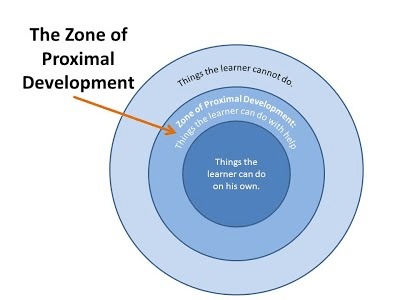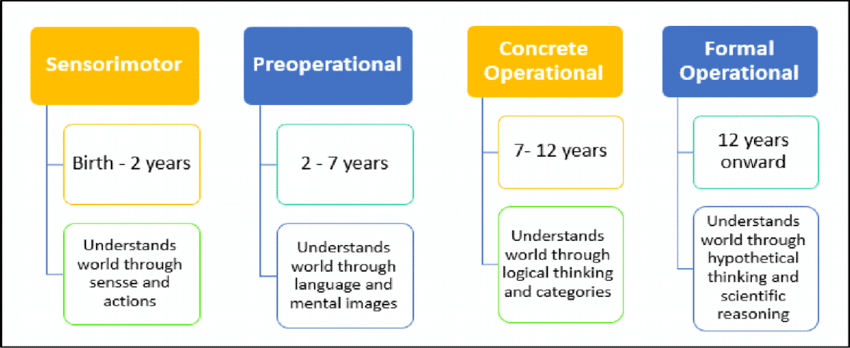In today’s fast-paced, digital world teachers and organizations are struggling to keep up with the ever-changing landscape of education.
With the rise of e-learning, schools and universities need to ensure they’re implementing learning strategies that work in an online environment for ongoing learning. Businesses, on the other hand, need to pull themselves up by the bootstraps and rapidly reform the way they’re conducting corporate training to encourage effective and scalable learning.
That’s where collaborative learning comes in.
As a company that specializes in communication and collaboration, we’ve seen the positive impacts of collaborative learning in many environments. We’re going to explain everything you need to know about collaborative learning. That includes how it can be implemented as a learning strategy at both an educational and corporate level, in order to boost engagement and give everyone the opportunity to be continual learners.
In this post, we’ll go over:
- What we mean by “collaborative learning”
- Key collaborative learning theories
- Online collaborative learning
- 3 strategies to excel with collaborative learning
What do we mean by collaborative learning?
What is collaborative learning?
Collaborative learning can be defined as an educational approach that emphasizes working together with others to enhance learning. It occurs when groups of two or more people work to engage in peer collaboration in order to learn, solve problems, improve decision-making, and complete tasks.
Collaborative learning activities usually focus on students’ interpretations, explorations, and applications of information. Rather than just on how the teacher presents it. It represents a significant shift away from traditional teacher-centered approaches to learning. These are instead replaced by a more communal, participation-based style of education and training.
In collaborative learning, students make a joint intellectual effort to actively engage with information and concepts to learn better. That’s in place of trying to memorize facts and figures. It’s all about working together to produce a more complete understanding of the information presented to them, by explaining a position, reframing concepts and information, and listening to others.
To sum up, the characteristics of collaborative learning include:
- Learning method based on communication
- Peer-driven learning that promotes interaction
- Social participation and interdependence
- Active engagement among peers, face-to-face or online
- Small group learning
In today’s digital world, we’re seeing an increase in online collaborative learning through e-learning platforms where students interact online in place of traditional campuses or institutions and use communications tools such as RingCentral to stay connected. Keep reading to find out more about online collaborative learning.
Collaborative learning assumptions
There are many different potential collaborative learning environments, from the traditional classroom to the virtual classroom, or the workplace. But, it’s tied together by some important assumptions about learning. These include:
- Learning requires active engagement: Participants must engage intellectually with concepts and information to construct meaning from it. This is more effective than listening passively to facts and figures, hoping to take them in.
- Rich context facilitates learning: Students are immersed in complex tasks and activities from the get-go, enabling them to develop problem-solving and higher reasoning skills.
- All learners are different: Participants bring different sets of experience, skills, learning styles, and goals to the classroom. Not everyone learns in the same way, and effective collaboration allows students and teachers to understand how they are learning and which experiences and perspectives inform their learning.
- Learning is social: Mutual exploration, feedback, and diverse perspectives can often enable people to process information better.
Collaborative vs cooperative learning
Collaborative and cooperative learning are easily and often confused. However, it’s important to note the difference when understanding learning strategies.
Cooperative learning refers to a type of collaborative learning where students are responsible for a specific part of their learning success and that of the group as a whole. Students are given roles and a structure to follow, then they must engage with a concept, understand it, and make sure that other members of the group understand it too.
It’s easier to understand what cooperative learning is if we can accurately identify what it isn’t. For instance, cooperative learning isn’t competitive learning where students sit side by side, work individually, and compete for the highest grade. In cooperative learning strategies, the group members’ success is dependent on the success of the group as a whole.
In comparison, when participants engage in collaborative learning they’re responsible for their own learning, and the success of their team as a whole. The way they participate, though, is left up to them. Unlike cooperative learning, there are no predefined roles or rules to follow, so the group must direct themselves.
Collaborative learning theories
In a world where most people are online, collaborative learning has adapted to suit our online lifestyles. Let’s take a look at some of the key collaborative learning theories, how they’ve shaped teaching strategies, and how digitalization has affected them.
Lev Vygotsky’s social learning theory and the Zone of Proximal Development
Lev Vygotsky was a psychologist who was known for his seminal work on psychological development in children. He developed his social learning theory, which focused on the role of social interaction in learning and cognitive development.
He argued that the community informs the creation of meaning and knowledge. Vygotsky believed that learning occurred on two levels:through interaction with others and then integrated into the learner’s mental structure.
An important aspect of his theory to note is the idea that cognitive development is limited to a “Zone of Proximal Development.” This zone describes the area of learning for which a student is prepared but needs help and social interaction to fully develop. For instance, a teacher, peer, or other facilitator can provide the student with the support they need to evolve their understanding of information and ideas:
If we take Vygotsky’s theory and examine it in terms of a contemporary online context, we can understand how it remains relevant in the virtual classroom. Teachers are adapting to new ways of implementing collaborative learning strategies into e-learning environments using education tools to create learning communities online.
Jean Piaget’s theory and stages of cognitive development
Jean Piaget was a Swiss theorist who suggested that children move through four major developmental stages as they mature. He posited that children construct an understanding of the world by actively participating in the learning process. Children experience the world around them and continue building new knowledge as they navigate the four stages of cognitive development:
In comparison to Vygotsky, who believed social interaction drives cognitive development in children, Piaget believed that they drive their cognitive development by adapting to new experiences. In the classroom, Piaget’s theory points to using short instructions, actions, and visual aids to enhance the child’s learning experience.
As children grow up in increasingly online worlds, the way that they navigate their stages of development has adapted to include digital knowledge. In this way, Piaget’s theory informs collaborative learning strategies in virtual classrooms by exploring the visual potential of online communication tools like video and webinars.
Online collaborative learning
Schools and universities are becoming increasingly digital, just like businesses. Virtual learning is growing in popularity, as students turn to e-learning out of necessity, convenience, or preference.
Technology is an integral part of our everyday lives, and as more digital natives enter into education systems, educators need to adapt to changing communication methods, student expectations, and the digital norm.
As digital campuses become more commonplace, educators need to up their game to ensure students are as engaged as possible in lessons. Badly put together video lectures and passive learning material isn’t enough to ensure students are learning to their full potential.
Introducing collaborative learning methods into the online classroom can hugely improve the experience of online learning. Encouraging students to get involved with the course material and with each other allows them to learn through active engagement with the subject matter:
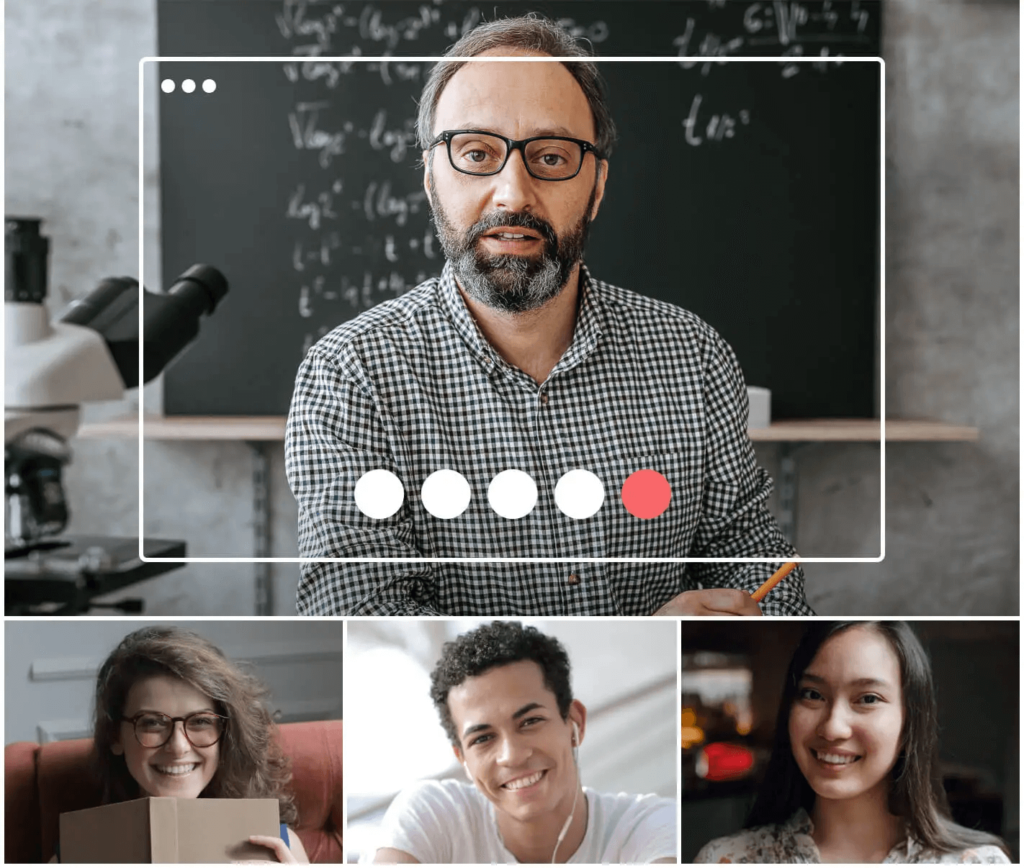
Online collaborative learning tools
Running an online class isn’t as easy as it may seem. Students are more easily distracted at home and more likely to disengage with subject material if it’s boring. So how can teachers make sure they’re executing collaborative learning strategies that keep students engaged?
An all-in-one online education solution empowers educators with all the tools they need in one place. It provides all the necessary platforms for teachers to collaborate, engage, and share information with students. Whether you’re dealing with children, teenagers, or university students, keeping all your communications in one place is essential to fostering engagement among students.
It features software for holding a daily or weekly class video meeting, a multi-channel contact center for reaching students via various touchpoints, and messaging for staying in touch outside of class or sharing instant updates. What’s more, a cloud-based online platform allows teachers and students to share assignments, homework, and files easily.
An online learning platform allows teachers and students to communicate seamlessly. It facilitates multiple communication channels through a highly integrated, frictionless environment. Students, parents, teachers, and administrators are all connected via one tool that allows secure communication through voice messaging, live chat, social media, or video call.
When it comes to online collaborative learning, RingCentral provides a secure solution for student collaboration on group projects. It provides a space where students work together towards a shared goal and to create a sense of community where they can learn from each other and build relationships.
For example, teachers can create a group space for individual classes where they can upload files, share documents, and more:
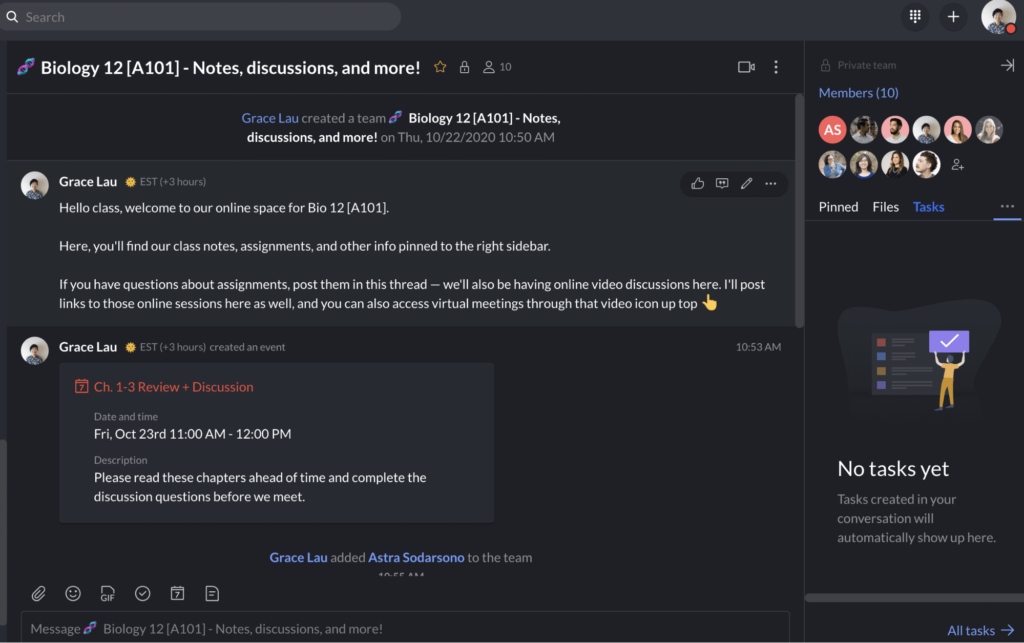
They can even assign homework through the tasks feature in the RingCentral app—with deadlines, details, relevant files, and even color-coding:
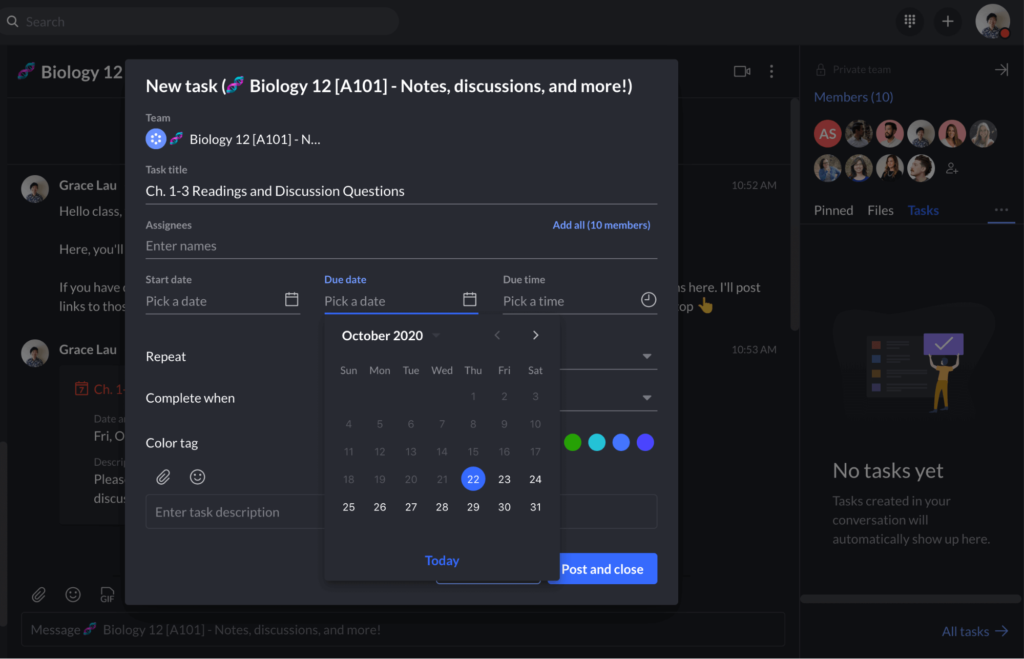
🕹️ Get a hands-on look at how RingCentral works by booking a product tour:
💰 You can also use this calculator to see roughly how much your business could save by using RingCentral to support your team’s communication with each other—and clients.
Collaborative learning in a business context
When we talk about collaborative learning, we often do so in the context of schools and higher education institutions, but how does it fit into a business context?
Many companies are already using collaborative learning strategies among teams to increase skills, boost employee engagement, and provide corporate training. With more and more businesses operating remotely, it’s particularly important to consider collaborative learning for businesses in an online context.
Business cycles are moving at a faster pace than ever before, which means businesses need to invest more effort into ensuring employees are thoroughly trained and re-trained. Online training is an easy solution to this, where learners can gather in an online space for small group training sessions.
Collaborative learning in the workplace can break the cycle of ineffective teaching methods and allow educators to improve employee engagement and satisfaction by:
- Aligning with digital collaboration and communication methods
- Fostering a sense of workplace community and improving teamwork
- Developing cognitive and non-cognitive skills that are vital to business success
Examples of collaborative learning
How do educators know when to use collaborative learning? Here are some examples to help you better understand where collaborative strategies fit into a learning framework.
In schools and universities, collaborative learning involves incorporating a group learning theory where small groups of students come together to achieve a common goal. It involves setting students up with collaborative learning activities like group discussions, debates, group work, and more.
In a business context, we can see examples in organizations using collaborative learning strategies to provide corporate training sessions and share information among teams. Examples include:
- IT teams creating video walkthroughs or holding webinars about new software regulations or instructions
- Marketing teams sharing content generation ideas on team messaging platforms
- HR departments creating and sharing onboarding manuals for new employees
Benefits of collaborative learning
Collaborative learning has been around for a long time, and it’s proven time and time again that it works. Otherwise, people would have stopped doing it, right? So why exactly is it important for students to collaborate?
Let’s take a look at some of the major collaborative learning benefits for individuals and organizations.
- Develops leadership and self-management skills
Learners can develop self-management and leadership skills when working together with others to achieve a common goal. Learners will have to teach, assign, and organize themselves to achieve productive results.
In a business context, employees can learn a wide range of skills from each other, enhancing their overall skill sets through engagement with new concepts.
- Enhances learning with diverse perspectives
When engaging in collaborative learning, learners can gain insight and access new information stemming from the diverse perspectives present in a group activity. Diverse perspectives are illuminating for the teacher and the student and provide insight into how other people learn and the effectiveness of learning strategies.
- Inspires critical thinking
Using problems as a starting point for collaborative learning activities, educators can inspire critical thinking in learners. Participants learn, after all, by interpreting and clarifying ideas, finding solutions to problems, and assessing the views and opinions of other students.
- Improves social interactions and develops interpersonal skills
When students have to work together to find a solution to a problem or complete a challenge, they learn how to relate to one another. Collaborative learning can result in friendships and frustrations, which means learners need to navigate complex social relationships while working efficiently and effectively.
What’s more, a study by GP Strategies found that more than 70% of respondents wanted to learn with someone else, whether it’s in a group, online, offline, or one-on-one. This reveals a clear link between social interaction and effective learning engagement.
In a business context, collaborative learning can improve relationships and teamwork across departments by providing a space for them to come together and learn with and from one another. It particularly benefits remote teams, who are often spread out around the world.
- Enhances knowledge retention
Collaborative learning requires participants to engage in a wider variety of activities and tap into high levels of thought. This results in improved knowledge acquisition and retention rates, as learners are more engaged with the information they’re processing.
- Improves problem-solving skills
For students preparing for life in the “real-world” and employees navigating the dynamic business world, problem-solving skills are critical. Collaborative learning requires participants to find solutions to clearly defined problems by working together. They must find solutions that are effective and efficient through group discussion, teamwork, and evaluation.
By tackling situations actively, students engage with the problem in a practical setting and improve their problem-solving skills as they find the best solutions along the way.
3 collaborative learning strategies
When it comes to organizing collaborative learning activities and running an online class, some strategies enable teachers and educators to achieve higher engagement levels and more successful learning.
In light of the current shift towards digital learning, we’ve decided to focus on strategies that facilitate effective collaborative learning in an online classroom. Implementing the right strategies alongside the best online teaching tools can make sure that you and your students are reaching your full learning potential.
1. Clearly define the expectations and purpose
As with almost any task in life, things just run more smoothly if you have a clear goal in mind. The same goes for implementing collaborative learning into your online classroom. Students need to know exactly what is in the syllabus and what is required of them in terms of participation.
RingCentral provides the ideal online education platform that allows you to share information and files via cloud storage. Students can benefit from easy access to clearly defined course outlines, a topic syllabus, and the standards they need to meet to reach and exceed success requirements.
Each student needs to be clear on what their role in the group is and what they need to do to succeed and learn. Whether you’re holding teaching meetings via video or have sent instructions via message, they need to be aware of the goal of the activity and why they should participate, instead of watching Netflix in another tab. RingCentral makes this simple with its easy-to-use video conferencing tool, team messaging, and business phone for staying in touch.
2. Keep groups small
As we’ve mentioned before, small groups are a key focus point of collaborative learning strategies. It’s particularly important in online teaching environments, where students’ voices can get lost in a sea of screens or the teacher has to mute everyone to be heard.
To ensure that everyone is participating and doing their part, it’s a good idea to keep to small group sizes. By keeping group sizes small, teachers can ensure that students are responsive and contributing to the group exercise. For younger students, this is particularly beneficial, as they are more prone to becoming overwhelmed and are still adapting to participating in the online classroom.
RingCentral makes this simple with cloud sharing so students can share ideas and resources in small groups. The teacher can set up online spaces for groups to work in, just like they were in a real classroom. Teams can communicate via messaging and video chat, and interact with each other through a fully integrated platform where all their work is stored securely.
3. Monitor and support
As an educator, you’ll need to be available to answer questions and provide support for students who might be struggling. In an online world, students might struggle to know exactly what they need to do or find it more difficult to understand concepts when it’s not being explained to them face-to-face. Encourage students to ask for support when they need it, and let them know that you’re there to help them learn.
RingCentral integrates video, messaging, and phone to make communicating with students seamless. They can choose their preferred method of communication and get in touch with you in seconds. With the video conferencing function, instructors can hold one-on-one meetings with and provide the whole class with instructions.
What’s more, RingCentral noticed that parents aren’t always connected to their email inboxes. So, we decided to make it easy for parents to check students’ progress from an integrated platform and to set up parent-teacher meetings at the click of a button.
Even in a virtual classroom, teachers need to foster an environment where students feel supported and comfortable asking for feedback or posing questions. With cloud sharing, instructors can provide feedback directly to students regarding their work through document annotations that make it easy for students to understand where they went wrong and how to improve for next time.
Collaborative learning; a powerful approach for the online era
Collaborative learning is a powerful educational approach that, when applied in the right way, can lead to student success at an educational level and drive business growth at an organizational one.
Collaborative learning requires students to work together to achieve a common goal, much in the same way that business departments are made up of people with different skills who come together to achieve results.
In today’s digital world, where remote education is an increasingly popular option, educators need to adapt methods of collaborative learning to an online environment to keep students engaged, happy, and learning.
Originally published Nov 10, 2020, updated Jun 18, 2024


